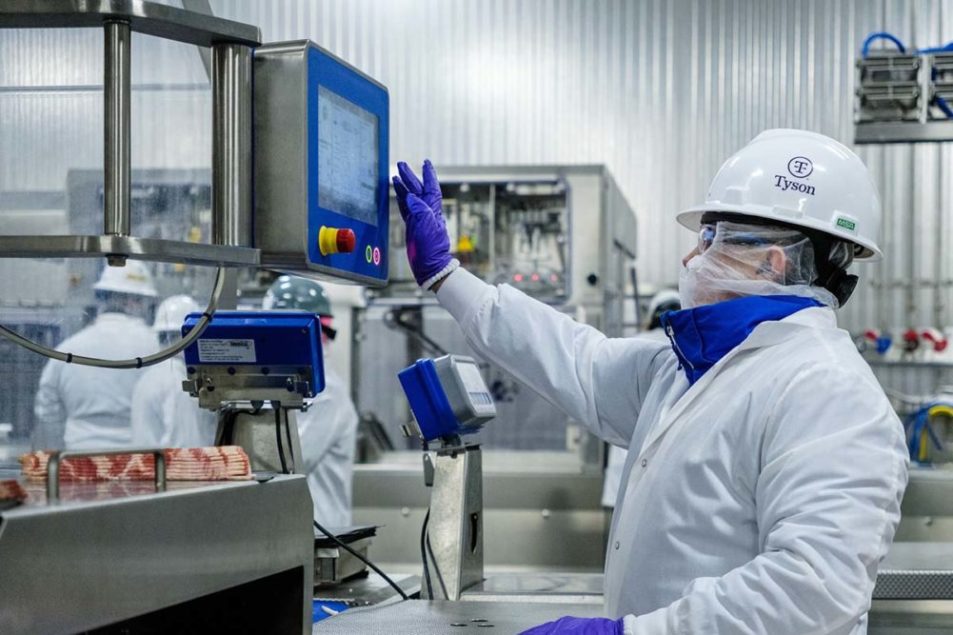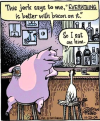Bourbon, Basketball, Bluegrass, Bacon...
The plant will feature Jimmy Dean and Wright Brand products.

www.foodbusinessnews.net
@THParent , this is a call to action. At least Tyson is trying to do something about it. Caitlin Clark (Iowegian by birth)
and Brock Purdy (Iowegian by choice) support this effort.
We’re Not Eating Enough Bacon, and That’s a Problem for the Economy
The American pork industry has become so efficient that demand can’t keep up with supply. In search of solutions, farmers and processors are looking at everything from new overseas markets to fattier, tastier pigs.
The American pork industry has a problem: It makes more tenderloin, ham, sausage and bacon than anybody wants to eat.
From giant processors to the farmers who supply them, they are in a predicament largely of their own making. They made production so efficient that demand can’t keep up with supply. Their long-running advertising campaign touting pork as “the other white meat” was remarkably effective at reaching consumers—but wasn’t actually the best way to market the product, some in the industry now argue, because it drew a direct comparison with chicken, which is typically more affordable.
And much of the American public thinks pork needs to be cooked to high temperatures that leave the meat tough and unappetizing, thanks to food-safety messaging that was highly successful but no longer relevant or necessary, the industry now says. Younger Americans are still gobbling up chicken sandwiches and burgers, but they don’t buy as much pork as older consumers do, a bad sign for the future.
People can’t agree on how to fix this.
Some think cultivating new overseas markets is the ticket. Others are trying to repackage pork as an affordable, easy-to-prepare alternative to beef. Yet another camp thinks the solution is to encourage people not to overcook pork and to breed some fat back into the meat.
At Carnico Foods, a small pork-processing plant in Litchfield, Mich., Scott Ferry is a fan of the more-fat approach. Ferry buys a hog-farming neighbor’s livestock and sells meat from fattier breeds, called Berkshire pigs, to upscale restaurants.
His neighbor is also crossbreeding Berkshires with leaner Duroc swine to create what they call “Buroc” pigs. Ferry uses the Burocs, which need less feed than Berkshires but still yield perfectly marbled pork, for fattier, more flavorful bacon products.
U.S. demand for pork is 9% less than what it was 20 years ago, according to estimates from Kansas State University. U.S. farmers produce 25% more pork than they did two decades ago.
The resulting glut has shrunk U.S. pork producers’ profit margins to their lowest levels since 1998, according to the American Bankers Association. Players big and small in the more than $50 billion pork industry are feeling the pain. Major processors like
Tyson Foods TSN -2.58%decrease; red down pointing triangle
lost millions of dollars on their pork operations last year. Farmers lost roughly $30 on every hog, according to Iowa State University estimates.
If pork producers can’t attract more young consumers, annual consumption will decline by 2.2 pounds per capita over the next 10 years, according to the Pork Board’s research, from
50.2 pounds last year.
“We are losing consumption, that’s a fact,” said David Newman, senior vice president for market growth for the National Pork Board, an industry-funded group charged with boosting pork’s position in the American diet. “We need to make pork relevant with the future consumer.”
Andrew Rasmussen, a 27-year-old health inspector in Chicago, is the kind of person pork producers hope to win over. During a recent trip to the supermarket, Rasmussen said he eats steak and burgers when they fit his budget and picks chicken when trying to save on his grocery bill.
“Pork is kind of a third thought,” he said.
ADVERTISEMENT
From Hog Island to Porkopolis
European settlers and explorers are believed to have brought the first swine as a source of food to American shores in the early 1500s. By the 1600s, the North American pig population had grown enough that Roosevelt Island in New York City was known as “Hog Island.” The expanding North American pork industry became entwined with capitalism—and this very news organization: Herds of roving pigs
complicated construction of a wooden wall Dutch colonists built in the mid-1600s to protect their Manhattan Island settlement. The same structure would eventually become the namesake for modern-day Wall Street.
An 1870 engraving showing pigs in Cincinnati, known for a time as ‘Porkopolis.’ PHOTO: PHOTO12/UNIVERSAL IMAGES GROUP/GETTY IMAGES
After the Revolutionary War, farmers pointed their hogs west, and packing plants followed in cities such as Cincinnati—for a time nicknamed “Porkopolis.” Much of the pork industry later shifted to the corn-growing states in the upper Midwest where producers had access to cheaper livestock feed. Carl Sandburg’s famous 1914 poem “Chicago” proclaimed the city “Hog Butcher for the World.”
The rise of industrial-scale hog farms, steadily increasing crop yields and growing overseas demand helped supercharge the U.S. pork industry in the late 20th century, and since the 1980s, pork production in the U.S. has roughly doubled. The U.S. Department of Agriculture projects the industry will produce nearly 28 billion pounds of pork this year, cleaved from roughly 125 million hogs.
The industry estimates it contributes roughly $57 billion to the U.S. economy and employs 610,000 people. In Iowa, the top pork-producing state, hogs outnumber people nearly eight to one.
That zeal for efficiency and expansion are a factor in the current troubles. Todd Thurman, a swine-industry consultant based in Texas who offers insights and training to farmers, governments and investors, said that production now is outpacing stalled demand, and slow population growth.
Big processors are looking for ways to make pork quicker to prepare, and pitching it as an affordable alternative to beef. PHOTO: TIMOTHY MULCARE FOR THE WALL STREET JOURNAL
“We’re a victim of our own success in a lot of ways,” said Thurman, who spends much of his time poring over numbers with hog farmers to figure out ways to save money on feed.
Practically everything that goes into raising hogs is now significantly more expensive: machinery, services, equipment, repairs, building materials, livestock-feed supplements and labor. Lower grain prices this year could help a bit and push down the cost of livestock feed.
Easier prep
In gleaming test kitchens in the southern Virginia town of Smithfield, professional meat cutters, chefs and marketing experts are betting on what they think could be the answer to pork’s troubles: bacon.
Aiming for a product that caters to our ever-tighter schedules, Smithfield Foods is introducing a quick-cook bacon under its Farmer John brand. The bacon will be roasted before it’s packaged, which the company says will cut cooking time in half. Crisp bacon usually takes about 20 minutes in the oven; Smithfield’s new version is done in 10 minutes, or just one minute in the microwave. It will be prepackaged on parchment paper, to make it easy for consumers to place in a microwave, oven or air fryer.
Products with faster prep times can help get more pork onto the plates of consumers who have less time to cook than they did during the pandemic, said Stephanie Kensicki, senior marketing director at Smithfield.
Tyson Foods is deboning more hams at its plants to produce more lunch meat and items like ham steaks, Chief Executive Donnie King said. The company is adding new cuts and offering more pre-seasoned pork loins among other cuts.
And Tyson opened a $355 million plant last month in Bowling Green, Ky., aimed at producing more bacon products for its Wright and Jimmy Dean brands.
“We’re trying to make meal prep easier,” King said.
People may start to see digital ads, targeted by location and demographics, sponsored by the Pork Board, the industry group in Iowa. Shoppers in Houston, for instance, may run across instructions for making Mexican pozole while scrolling their Instagram feeds, compliments of the digital-marketing department in Iowa.
“We’re doing a targeted approach, identifying markets and targeting individuals with recipes,” said the Pork Board’s Newman. “We need to remind them there is pork beyond bacon.”
If only pork could be a strong supporting player, on the side of a dish, instead of a main, Newman says. That way, it wouldn’t have to compete head-on with sirloin steak and chicken. He wants to push ground pork as an ingredient for meatballs or stir fry.
A polarizing animal
If younger Americans don’t start buying more pork, annual consumption will drop by 2.2 pounds per capita over the next 10 years. PHOTO: TAYLOR GLASCOCK FOR THE WALL STREET JOURNAL
In the 1960s and early ’70s, beef was king among American consumers and pork held second place, but chicken overtook pork in 1986 as poultry production skyrocketed, making it the cheapest of the big three meats. By 1993, chicken became the most-eaten meat in America.
Religious prohibitions in Islam and Judaism may limit pork’s popularity, along with a sense among some that
pigs are too smart to slaughter.
On the other hand, some consumers are more passionate about their love for bacon than any other meat, observed Helen Zoe Veit, a food historian at Michigan State University.
ADVERTISEMENT
“The pig is a polarizing animal,” she said.
Producers like Brady Reicks, a sixth-generation hog farmer from northern Iowa with 60,000 sows, hope the Pork Board’s efforts, among others, will make the industry less reliant on exports.
The huge scale of Reicks’s operation, an ample supply of grain and a long-term arrangement to supply Tyson Foods’ Waterloo, Iowa, pork plant has helped him weather some of the industry’s turbulent cycles. Reicks says he’d be open to changing some of his operations, such as switching to an antibiotic-free program, if it meant making a few extra dollars on each animal.
Smaller farmers don’t have Reicks’s advantages and some, especially older farmers with no clear successor, could leave the business, he said. The industry needs U.S. consumers to help stabilize profits, he said, and keep hog farming viable for younger generations.
“We’ve got some work to do,” Reicks said.
Maybe it’s us
Some say pork is misunderstood. Alexis Fenstermacher, a 25-year-old nurse in Philadelphia, says it’s her favorite meat, despite it not getting as many points for health or taste compared with chicken and beef. “When cooked right it can be better than a steak,” she says.
ADVERTISEMENT
That’s exactly what Tyson Foods, the biggest U.S. meat company by sales, has in mind. Tyson recently launched a new product called a “pork griller steak,” a cut that’s sliced differently than a traditional pork chop. It’s seasoned and marinated with either a steakhouse or herb and olive-oil flavor, said Ty Baublits, whose team spent the past 18 months perfecting the cut in Tyson’s Springdale, Ark., test kitchens.
The precise difference of the cut is a company secret, but Baublits said it resembles a flatiron steak—a
shoulder cut developed by the National Cattlemen’s Beef Association in 1998. That helped ranchers and meatpackers generate more value from each carcass.
Tyson’s pork steak began hitting supermarket meat cases about nine months ago, and Baublits said the company hopes to entice shoppers turned off by pricey sirloins and T-bones.
A 2003 ad from the long-running ’other white meat’ campaign., which some now think backfired by comparing pork to chicken, which typically costs less. PHOTO: THE PORK BOARD
For years consumers have cooked pork to internal temperatures of 165 or 170 degrees to protect against the disease trichinosis—and likely have overcooked the meat in the process, said Glynn Tonsor, a livestock economist at Kansas State University.
The USDA lowered the recommended safe cooking temperature for whole cuts of pork to 145 degrees in 2011, decades after improvements in pig-raising practices reduced the risk of trichinosis, but some consumers still follow the old rules, Tonsor said. The industry is now pushing 145 degrees as the recommended temperature.
The hog industry has spent years breeding some of the fat out of pork by making the animals leaner, which makes the meat easier to overcook, said Tonsor. A 2006 USDA study said some cuts of pork were on average 16% lower in total fat.
Thurman, the hog-industry consultant, said the most ubiquitous pork tagline—“the other white meat”—has sent consumers the wrong message since its launch in the late 1980s, by comparing pork too much to chicken.
“ ‘It’s like beef but cheaper’ would have made more sense,” Thurman said. Newman at the Pork Board said that while the campaign was widely recognizable, the group dropped the slogan in 2011 in favor of different marketing techniques, including “Real pork makes a real difference.”
Looking overseas
A worker at Smithfield Foods, which like other big processors has been seeking new ways to present pork as an affordable, easy-to-prepare alternative to beef. PHOTO: DANIEL ACKER/BLOOMBERG NEWS
American pork producers have increasingly banked on consumers in other countries. The industry typically exports about 25% to 30% of product, industry officials say. Sales to China, the world’s top pork-eating nation, surged following a hog-disease outbreak in the country in 2018. Producers in the U.S. responded by expanding capacity even further, with new processing plants in northern Iowa and southern Michigan.
Chinese pork producers rebuilt their herds, however, and exports to the country have plummeted over the past two years, contributing to U.S. oversupply and pressuring meatpackers’ profits.
WH Group
, the China-based owner of Smithfield Foods, said last fall that high costs of hog production and low sales value of pork products hurt its bottom line. Arkansas-based Tyson lost $139 million in pork operating income for its 2023 fiscal year.
Exports to Mexico have been increasing. In January through November of 2023 pork exports to Mexico totaled over 995,000 metric tons, up 13% from the previous year. That helps offset the decline in exports to China, and trade groups have been trying to cultivate other markets in Asia, like Vietnam.
Profits for processors are expected to improve this year. Tyson said its pork business should break even or make $100 million in 2024.
In the U.S., retail ground-beef prices were up 9% in December versus the prior year and sirloin steak prices were up 15%, according to federal data. But retailers say that consumers aren’t picking up pork chops and sausage instead.
“There should be greater demand for pork with beef prices where they are, but it’s not happening,” said Ferry.
Pigs today are leaner on average than they used to be. Some in the industry believe breeding some fat back into the animals will yield more flavorful meat that’s also less likely to become overcooked. PHOTO: SYLVIA JARRUS FOR THE WALL STREET JOURNAL







